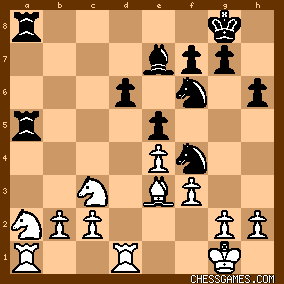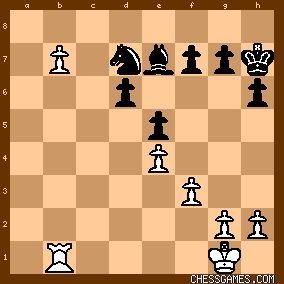| May-30-07 | | YouRang: For the record, I spent some time checking the endgame with a computer. Geller *might* have had a stronger move with 44. Kb3 (instead of Rxd4). This gets his king into better position for supporting the pawn push. For a while, it looked like this might even be winning. But I think it turns out that black, playing very accurately, can (1) exchange rooks, (2) take time to eat the h2 pawn, (3) exchange the bishop for the d-pawn, (4) use his kingside pawn advantage to neutralize white's material advantage. (In fact, in the end, it might be white having to play very accurately to hold a draw.) |
|
| Jun-02-14 | | Howard: Haven't I read before that Geller missed a way to develop a significant advantage in this game ? Since I don't have a computer, perhaps the many of you who DO, could shed some light on this. |
|
| Jan-30-16 | | Howard: To reiterate, I'm pretty sure that Bobby Fischer's Chess Games (long out of print), states that Geller probably missed a win in the middlegame. Anyone wanna shed some light on this? |
|
| Jan-30-16 | | TheFocus: <Howard> Karsten Mueller in his book <Bobby Fischer The Career and Complete Games of the American World Chess Champion>, gives 30.Kf2? and suggests instead: "30.Ng3 makes better use of White's Knights: 30...Rc2 (30...g6 31.Nb4) 31.Nb4 Rb2 32.Nc6 Bf8 33.Ra8  ." ."And 33.Nxd5: "It is probably better to preserve the active Knight with 33.Nc6!? Bc5+ 34.Ke1 dxe4 35.Nc3 exf3 36.gxf3." |
|
Jan-30-16
 | | offramp: 
click for larger view
26.b3! Rc8

click for larger view
27.b4! A rare consecutive single move move an unmoved pawn. After 30...Ra3

click for larger view
Geller might have played, instead of 31.Nb4, 31.Nac3. This threatens, of course, Rxa3. But if black exchanged by ...Rxa1 he seems to find himself ina bit of trouble... |
|
Jan-30-16
 | | offramp: So if Geller had played 31.Nac3,

click for larger view
then if Black had played 31...Rxa1 then 32.Rxa1 threatens Ra7 when the pawn on d6 might become weak, and white might also push the b-pawn. But Black could give up a rook for two knights. 31.Nac3 Rcxc3 32.Nxc3 Rxc3.

click for larger view
33.b6!

click for larger view
33. ...Rxc2+ 34. Kg1! (This is better than Kf1, when the K+R are susceptible to a knight fork if the knight arrives on c4.) 34...Rb2 35. Rab1 Rxb1 36.Rxb1 Nd7 37. b7 Kh7,

click for larger view
38.Rc1!  . .
So that might be where Geller missed a bit of a chance. |
|
| Jan-30-16 | | Howard: Please check the third diagram. How did the b-pawn suddenly jump from b4 to b5 ? |
|
Jan-30-16
 | | offramp: <Howard: Please check the third diagram. How did the b-pawn suddenly jump from b4 to b5 ?> It was a recipient of propulsion via the agency of Geller's right hand during the execution of 28.b4-b5. |
|
Jan-30-16
 | | beatgiant: <offramp>
In your last line above, why 37...Kh7 instead of 37...f6 38. Rc1 Kf7? |
|
Jan-30-16
 | | offramp: <Beatgiant> Not much of it is forced, just reasonable... |
|
| Jan-30-16 | | TheFocus: Nice analysis, men. Thanks for sharing.
I had not looked much at this game before, but am glad I did now. |
|





